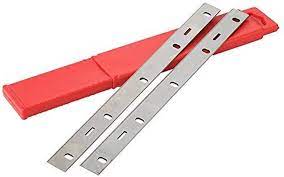I’m here to give you a quick rundown of thicknesser blades and how they work their magic in the woodshop. Essentially, these blades are what allow a thickness planer to smoothly shape rough lumber. They’re designed to evenly shave off thin layers of wood from the surface. Kind of like those push mower blades that zip around to trim your lawn!
What’s the key difference with planer blades you ask. Well, to summarise the main differences:
Planer Blade Uses Thicknesser Blade Uses
Trim thinner pieces (a few mm) from the sides or ends of boards. Usually used to trim doors and edges of boards Take wider cuts to remove material from the faces/surfaces of boards. Goal is to create a consistent, uniform thickness across the whole board
So in plain terms, planer blades are for shaping the edges, while blades of a thicknesser are more for flattening and truing up the faces of boards. Planers handle narrow passes on the sides, thicknessers handle broader cuts on the surfaces.
The blades of a thicknesser remove material from rough lumber thanks to their sharp cutting edges. Essentially, they are mounted on a fast-spinning drum or cylinder inside the thicknesser machine. As the lumber passes through, the spinning blades make contact and gradually shave off layers of the wood surface. Each pass removes a thin layer, correcting imperfections.
The key is that the blades cut in a repeating pattern, resulting in an evenly smoothed surface across the whole board. Meanwhile, the feed mechanism controls the lumber’s movement to maintain a consistent thickness. Through this repeated slicing method, thicknesser blades are able to true up rough or uneven wood surfaces. The high-speed blades and controlled feeding allows for precision thickness planing.
One of the key aspects of how thicknesser blades work is their adjustability. Blades can be raised or lowered to set the cutting depth precisely. This allows woodworkers to remove only the necessary amount of material in controlled passes. Being able to dial in the blade height means getting boards accurately trimmed to the intended thickness. No more guessing or over-cutting, just repeatable precision thanks to the adjustment mechanism.
